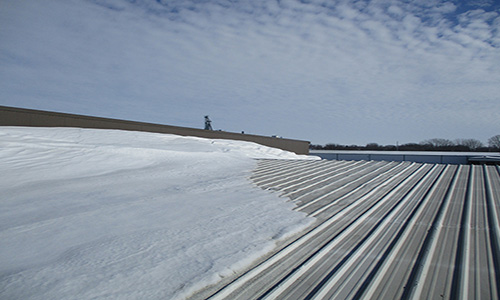With snow flying at this time of year, you may be concerned with the amount of snow on your roof. Doing a roof assessment for snow loads is the first step to make sure your facility’s roof is structurally sound and may also save you money on insurance premiums.

Why are snow drifts a concern?
Snow drifts occur when there are differences in roof heights. They create stress on the roof structure, which can lead to:
- Water leaking onto machines and workers
- Roof deflections causing problems with supported process equipment or ceiling sag
- At worst, roof collapse at the snow drift locations
Who needs a snow load assessment?
Older Buildings – Prior to the 1980s, it was not common practice for structural engineers to consider snow drifts in roof design. Most were designed for a flat snow load, and it’s possible these facilities may not be able to handle current snow drift loads.
Facilities that have expanded – Snow drifts are a common occurrence at industrial facilities, which often have varying roof heights. This happens when building additions are made due to expanded production, or when different roof heights are required for a new use of the space or new machinery.
How a review is done
A structural engineer will conduct a site visit to identify areas on a facility with different rooflines where snow drifts can accumulate. The engineer will get exact measurements of the height differences, either from a plan set, a field assessment, or a 3-D scan.
For most industrial facilities, data sheets are used from the International Building Code. Facilities insured by Factory Mutual (FM) Global have a more stringent set of data sheets. Using information from these data sheets, roof measurements are compared with snowfall amounts per region of the country, which can calculate expected snow drift amounts. The snow load is then compared to the capacity of the roof structure, whether it’s concrete, wood, or steel-framed.
If the snow load assessment finds the roof structure inadequate to handle predicted snow drift amounts, the most common solution is to reinforce the roof structure to increase its capacity. However, facilities can also develop a safety plan where an approved system monitors snow drift amounts. An approved snow removal plan can be put into effect to manually remove the drift from the roof.
Benefits of Doing a Snow Load Assessment
- Safer facility, for the product and employees – A roof collapse can be very costly to any facility. Completing an assessment will give you the peace of mind that you’ve done your due diligence, and if any changes are necessary that you’ve taken the steps to address them.
- Lower insurance premiums – Insurers look at everything that can affect the building and products inside when deciding a facility’s status, and therefore the amount of its premiums. Even if the assessment is not asked for by your insurer, you can be proactive and ask your insurance provider how a snow drift analysis could help your premiums. For example, a Highly Protected Risk status will offer lower premiums to those facilities that address problems found in their yearly inspections. With lower premiums, conducting an assessment may ultimately pay for itself.
- Prevent future issues – Every moment a production line is shut down or your building space is non-accessible means lost profits for the company. Making sure your roof is structurally able to handle snow drift loads will prevent future problems from affecting your production.
Any time is the best time for facilities to hire a structural engineer to do a snow load assessment. Be proactive and allow yourself enough time to conduct an assessment, draw design plans and develop a construction schedule that works for you.

